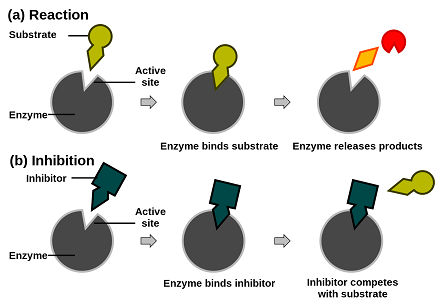Allosteric enzyme regulation is an important process where covalent modification is needed to modify the enzyme. To get a clear concept of this topic you have to know what is an allosteric enzyme, regulatory enzyme, etc. Ok, don’t worry I will give you a little touch about those topics.
Allosteric Enzyme Regulation and Covalent Enzyme modification
To discuss Allosteric Enzyme Regulation and Covalent Enzyme modification, we should know that both reversible and irreversible covalent enzyme alteration (i.e. enzyme modification) plays a major role in enzyme function regulation.

Enzyme Regulation – Allosteric Enzyme Regulation is the topic of our discussion. You would learn what is a regulatory enzyme, enzyme regulation and Allosteric Regulation, and Covalent modification.
Read about: Fundamentals of Enzyme: how do they work?
Regulatory Enzymes:
A regulatory enzyme is an enzyme in a biochemical pathway which through its responses to certain signals, regulates the pathway’s activity.

For example- In cellular metabolism, groups of enzymes work together in sequential pathways to carry out a given metabolic process. The activities of metabolic pathways in cells are regulated by the control of the activities of regulatory enzymes.
Regulation of Enzyme Activity:
Some of the regulation of enzyme activities are-
- Allosteric regulation
- Covalent modification
- Association-disassociation
- Proteolytic cleavage of a proenzyme
But here, we only discuss the Allosteric regulation and Covalent modification in this article.
What is Allosteric Regulation:
Allosteric regulations are the regulation of activities of an enzyme or a protein caused by the binding of modulators ( or effectors) at a site other than the active site of the enzyme or protein. There are two effects of Allosteric regulations and two effectors are may be available for the effects-
Effectors maybe-
- feed-forward activators or
- feedback inhibitors
Feed-forward activators (modulator):
The modulator which is responsible for increasing the enzyme activity of the enzyme by enhancing the attraction among the enzyme as well as subtract is known as the feed-forward modulator.

when a positive modulator is attached to the Enzyme then the enzyme becomes more active and when the Enzyme attached with the negative modulator then the enzyme becomes less reactive.
Feedback inhibitors
On the other hand, the modulator which is responsible for decreasing or destroy the enzyme activity permanently is known as the feed-back inhibitors.
Covalent Enzyme modification:
Covalent enzyme modification is a process of regulating the activity of an enzyme. The covalent enzyme modification is mainly in two types. they are-
Reversible covalent modification: In metabolic control, modulation of enzyme activity by attaching or releasing tiny groups plays a very significant role. The phosphorylation of particular serine, threonine, or tyrosine groups is probably the most universal, and definitely the most well-understood reversible covalent modification.
Irreversible covalent modification: Specific peptide bonds are often used for proteolytic cleavage to activate enzymes. This process is the irreversible covalent modification. Since proteolysis is irreversible, turning the activity less requires another mechanism such as the binding of inhibitory proteins to the enzyme.
Reversible Covalent Modifications:
- Reversible covalent modifications require an expenditure of energy and are often used in signaling from extracellular messages.
- In contrast, noncovalent interactions are reversible with no metabolic energy expended and sense conditions within a cell.
- Reversible covalent changes are known to change the activity of the enzyme such as:
- Phosphorylation of serine, threonine, or tyrosine and less frequently aspartate and histidine residues.
- Acetylation of lysine or amino-terminal groups.
- Methylation of glutamate or aspartate residues
- Nucleotidylation of tyrosine residues
- ADP ribosylation primarily of arginine residues.
For example, we discuss the Phosphorylation and Dephosphorylation – 
Phosphorylation and Dephosphorylation
- A family of enzymes called protein kinases that use adenosine triphosphate (ATP) as a donor of phosphate catalyzes phosphorylation processes.
- Phosphate groups are cleaved from phosphorylated enzymes by the action of phosphoprotein phosphatases
- The objectives for phosphorylation are amino acids with –OH groups.
Follow Us On Facebook, Twitter, Linkdin, and Youtube.
Read More About:


Leave a Reply